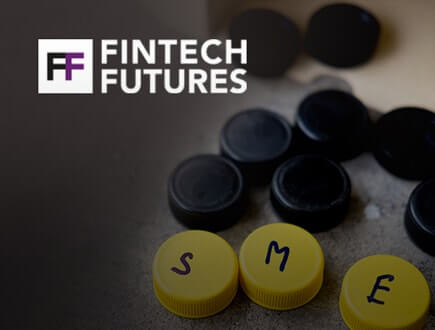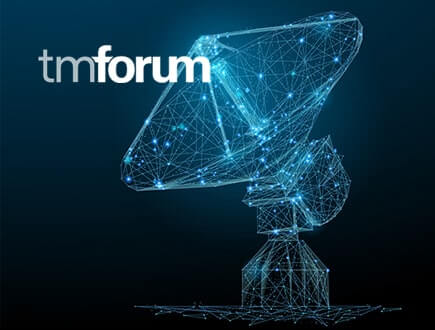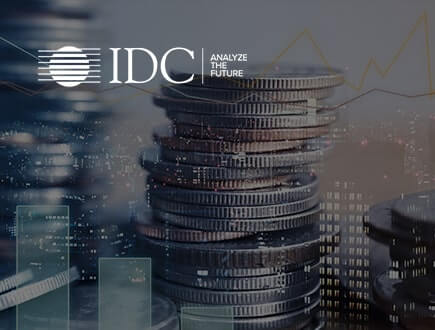Imagine this…
You are coming back from work. Your smart car senses the location and using the facial recognition software it opens the gate for you. Your finger print recognition system identifies you and opens the main door of your house. Upon entry, it adjusts the lighting of the house based on your mood.

The lights go on in the kitchen and living room, maybe your bedroom and hallways. Your favorite music will start. The thermostat will adjust the temperature of the room. The hot water is ready for you to take a shower. You predefine the environment settings for various activities like romance, reading, dinner parties and more. The LED screen displays you the notifications and schedule for the next day. The screen on the dressing room tells you the right attire to wear for the next day by checking the weather, calendar and your wardrobe inventory.
You have a computer sensor in your floor that will monitor your physical health and your diet plan. The Wi-Fi enabled smart fridge displays various recipes that can be prepared from the available food inventory. The smart board on the fridge informs you the best value for money food items by comparing the preferred supermarkets and order is just a click away. It warns you the shortage of food items to be stacked in and the spoiled food that needs to be thrown out. The smart board also provide you an option (especially if you are a bad cook) to order the food from the most preferred take away restaurants.
You are living in a smart world of connected networks with hidden objects and wearable sensors which are context aware. Instead of you providing the commands, objects around you know what you like, what you need and act accordingly without explicit instructions.
It understands your health, travel plans, vacation suggestions, work schedule, your favorite food, cloths etc. It will look after you from the time you get up in the morning till the time you go to bed and also during your sleep. This smart living environment is programmed to make your life easier and smarter. It understands your personal preferences and intended course of action.
Welcome to the world of Ubiquitous Computing, a futuristic prediction to view the world from a different perspective.
What is Ubiquitous Computing?
Mark Weiser, a Chief Scientist at Xerox, PARC (Palo Alto Research Center) coined the term Ubiquitous Computing in 1988. It’s also called Ubicomp in short. Ubiquitous means everywhere and anywhere. It is the concept of proper imbedding of computers into the everyday world. Ubicomp can be considered as a subset of Internet of Things (IoT). It’s also called Pervasive Computing.
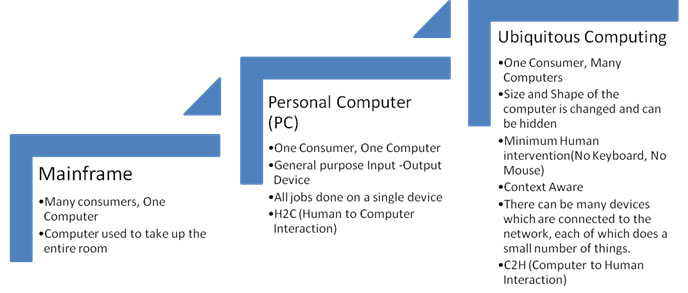
From the Mainframe era (one computer, many people), the technology has been transformed to the PC era (one person, one computer) and then to the much anticipated Ubiquitous (one person many computer) World. The catalyst for the massive growth of PC was the enablement of world wide web and internet access. This helps people to get connected across the globe. The introduction of smart phones and revolutions in the telecommunication industry (m-commerce) helped people to get connected while on move. The Human Computer Interaction (HCI) was explicit. The Human to Computer Interaction (H2C) has been performed through the input devices like keyboard or mouse.
With the introduction of Ubiquitous Computing, there is paradigm shift in terms of this interaction. Along with explicit Human Computer Interaction (eHCI), it will consider the Implicit Human Computer Interaction (iHCI) as well. Instead of Human To Computer (H2C) interaction, the machines will interact to other machines and humans which also known as Computer To Human (C2H) interaction. The C2H interaction is done through the sensors and sensor-nets based on context awareness. The Shift from eHCI design to also include iHCI design will be a key enabler for effective Ubicomp systems.
“The most profound technologies are those that disappear. They weave themselves into the fabric of everyday life until they are indistinguishable from it.” - Mark Weiser, 1991

The growth in the field of Ubiquitous Computing has been mainly driven by the advancement in Technology. The revolution of smart phones and tablets, advancement in communication networks coupled with the wireless and broadband technologies, sophistication in the development of sensors, seamless integration through SOA (Service Oriented Architecture) and the emergence of Cloud Computing for the highly available and resource pooling capabilities taking it closer to the ubiquitous computing goals.
The rapid growth in the number of sensors in the ubiquitous environment produces large volume of data. In order to handle these data to process and analyze (“Big Data”) at real time based on the context is vital. Based on a Forbes study, there will be data equivalent to 72 million Libraries of Congress available online and the ubiquitous connected network that will make that data instantly available to anyone, anywhere.

In Ubiquitous world, computers will be generally small (for ex. micro-chips). It can be in any shape (like tags that can be attached to an item). These objects can be hidden and are part of the connected network. People use them unconsciously to accomplish everyday tasks.
The context awareness plays major role to collect quality information. This can be done through sensing the human eyes and ears and skin to retrieve the information. Recognizing the user behaviour needs and intents are important part of the context aware services. Also the data needs to be accessed from anywhere (through mobile or the wearable). For example, with the help of VMWare, The desktop virtualization technology makes it possible to access virtual desktop services from any location and any device. The Ubiquitous middle-ware will shield application from the low level details and handle the business rules.
Current Trends & Major Players in the market
|
Major Players |
News & Source |
 |
Apple’s recently awarded gesture based patents |
 |
The company's security ecosystem will integrate with Cisco Internet of Things products, with the goal of providing developers a common platform to deliver solutions for public safety, utilities and industrial environments |
 |
Facebook to buy virtual reality firm Oculus VR for $2 billion According to CEO Mark Zuckerberg, the company hopes to provide a new way to communicate and share experiences, essentially incorporating social technology into every aspect of our lives. Still, there are a number of important differences between Facebook's plans for a virtual reality world Facebook's Deep Face facial software nears human levels of accuracy |
|
Google's view of an augmented reality world. Recently, the project made headlines when Google announced a partnership with trendy eyewear firm Luxottica, which owns brands such as Ray-Ban and Oakley. |
|
 |
Office on the iPad Microsoft’s commitment to a ubiquitous computing future of devices and services, then new certainly should after today’s launch of Office on the iPad. |
 |
US chipmaker Intel steps up its investment in wearable technology with the acquisition of Basis Science, a firm known for its health tracking services and devices. |
|
IFTTT (If This Then That) is one of the websites around for setting up automation tasks. It uses web services that enable users to connect different web applications It allows creating business rules that can be configured based on simple If Else Then That condition to create a smart environment. |
|
Consumer Products |
Product information & Source |
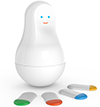 |
“Mother,” (by Sen.se), known as the “world’s first programmable mother” provides the smart home connectivity. Any devices (for ex. Refrigerator, toothbrush, Fridge etc) can be connected to Mother through cookies. This smart “Mother” will provide recommendations of improvements in terms of suggestion, reminder and congratulate on a job well done. It’s termed as a Lifestyle management device. |
 |
Beddit mattress monitor which collects data during the sleep. “Beddit automatically tracks your sleeping patterns, heart rate, breathing, snoring, movements and environment. In the morning, Beddit tells you how you slept and how to do it better” |
 |
Tesla Smart Car The Smartcar’s Intelligent Climate technology learns a your driving habits and automatically pre-conditions their vehicle to the perfect temperature before you even get into it by anticipating your next commute. |
 |
Google is in process of acquiring Nest, who are producing the Smart thermostat across US and UK |
 |
HUDWAY turns your windshield into a jet fighter cockpit |
Are we ready for it?
The realization of ubiquitous computing poses several challenges. Smart environment consists of a several number of micro-chips and sensors with associated software. Most of the household equipment’s are connected to each other in a network. There might be dead spots where connectivity may not be available and a drop in wireless signal at your home can cause the system to de-function. Reliance on satellite can be an expensive option. Compared to the conventional network, we don’t have a system administrator to manage the smart network.
The environment is vulnerable to cybercriminals and hacker community which can lead to invasion of privacy and other losses. In pervasive era, there are numerous interconnected computers and hence it is a challenge to ensure a safe environment. The manipulation of ubiquitous environment causes the system to behave differently and can be controlled from an external device (for ex. counterfeit chip). This poses a larger threat to the community. Remember “I Robot”?
Applications
The progress of ubiquitous environment depends on advancement of technology. The environment has to be self-configurable and self-healable. With the implementation of robust computer networks (using Ethernet technologies and security gateways), the network can be fast and reliable.
The potential of Ubiquitous computing is huge and have an impact on many areas of the field. Introduction of smart cars can help to avoid accidents and provide easy routes. Smart energy meters give better energy performance. Easy maintenance of house hold equipment is possible as the sensor tag attached to the equipment lets you know when the maintenance is due or when the warranty expires to avoid any costly repairs.
In healthcare field, embedded smart chips will automate and regulate processes and improve the patient’s environment. A healthy eating smart environment can reduce the obesity levels. It can also provide a comparative study of fast food vs. home food which promotes health awareness and quality of life.
The cameras at your door could identify the family and friends and also strangers. Any stranger with a criminal background can be checked against the criminal database and an automated emergency call and email (with photo) will go to nearest police station
Final Thoughts
“Similar to the way traditional phones were evolved as smartphones, there will be more consumer objects which will soon be evolved as smart objects like smart appliances, smart glasses, smart watches, smart cloths, smart cars, smart conferencing, smart homes, smart environment and a Smart World”. |
The ultimate goal of Ubiquitous Environment is to make life simpler and smarter. There are significant progresses in terms of regulatory measures. The wearable technologies like Google Glasses, Smart watches, Smart Heart Rate monitors etc. are getting wide popularity in the market. The future is bright and the pros outweigh the cons. The ubiquitous environment is here to stay, mature and evolve over time. The days are near when you will go shopping for a hot wearable device like a Google powered Ray ban or Oakley smart glass, a smart bracelet, an apple iWatch or even a smart body analyser. The many devices and services we manage are anything but “[woven] into the fabric of everyday life”. Can this be the next wave in computing? |
Related Posts
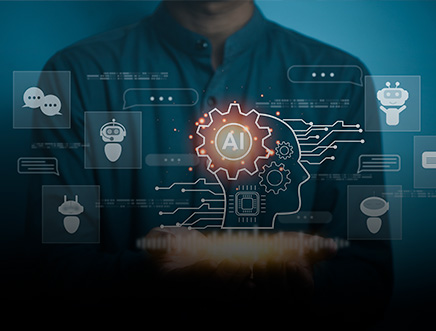
Conversational AI- a sophisticated data-driven technology enabling human-like dialogue across digital platforms–is empowering businesses from diverse industries to deliver quick, friendly, scalable, and personalized customer experiences round the clock.
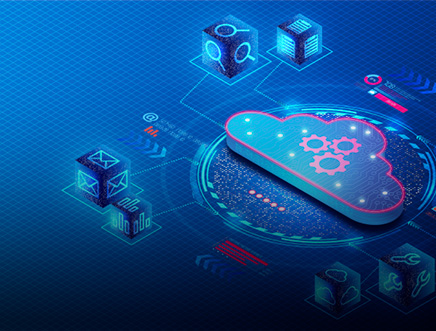
In 2008, a significant outage in its data center prevented Netflix from sending DVDs to its customers for three days which prompted the company to rethink its IT architecture.
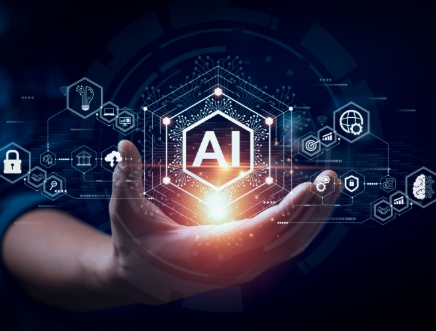
Generative Artificial Intelligence (Gen AI) has taken businesses to the edge of a new frontier that promises unprecedented levels of productivity, innovation, and new revenue streams.
Whitepaper


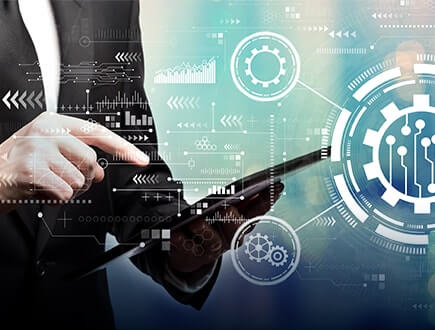
Analyst Speak

(THIS) has been cited among notable vendors by Forrester Research in its report ‘The API Management Software Landscape, Q1 2024’. The report recognizes Torry Harris as a provider offering API management solutions with a geographic focus in the EMEA & APAC regions.

Forrester observes that the initial rush to “lift and shift” to the cloud has now been replaced by a focus on modernization and digital transformation. Cloud migration is the first step in a long journey to take advantage of the latest cloud-native technologies and services.

Torry Harris is a 'Strong Performer' in The Q3 2022 Forrester Wave™ for API Management Solutions. This report shows how each provider measures up and helps technology architecture and delivery (TAD) professionals select the right one for their needs.
Past Webinars
